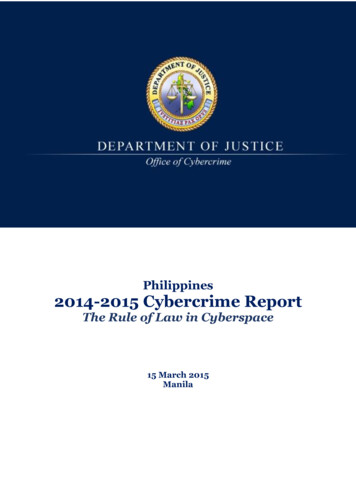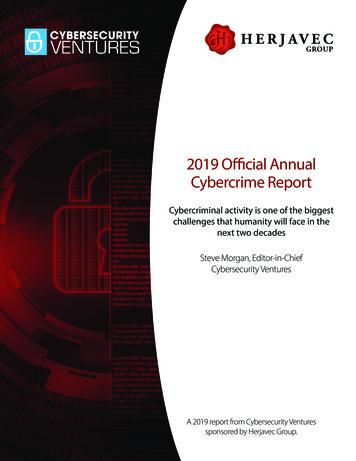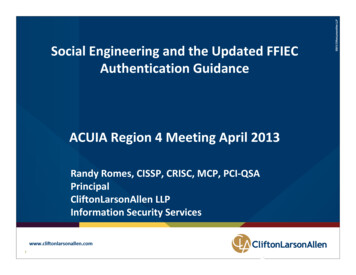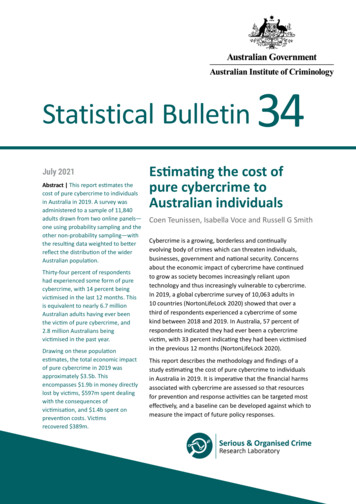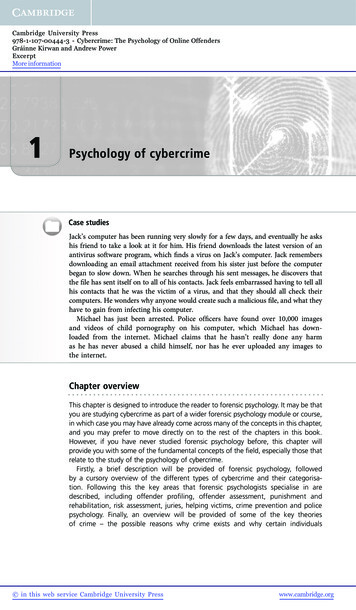
Transcription
Cambridge University Press978-1-107-00444-3 - Cybercrime: The Psychology of Online OffendersGráinne Kirwan and Andrew PowerExcerptMore information1Psychology of cybercrimeCase studiesJack’s computer has been running very slowly for a few days, and eventually he askshis friend to take a look at it for him. His friend downloads the latest version of anantivirus software program, which finds a virus on Jack’s computer. Jack remembersdownloading an email attachment received from his sister just before the computerbegan to slow down. When he searches through his sent messages, he discovers thatthe file has sent itself on to all of his contacts. Jack feels embarrassed having to tell allhis contacts that he was the victim of a virus, and that they should all check theircomputers. He wonders why anyone would create such a malicious file, and what theyhave to gain from infecting his computer.Michael has just been arrested. Police officers have found over 10,000 imagesand videos of child pornography on his computer, which Michael has downloaded from the internet. Michael claims that he hasn’t really done any harmas he has never abused a child himself, nor has he ever uploaded any images tothe internet.Chapter overview.This chapter is designed to introduce the reader to forensic psychology. It may be thatyou are studying cybercrime as part of a wider forensic psychology module or course,in which case you may have already come across many of the concepts in this chapter,and you may prefer to move directly on to the rest of the chapters in this book.However, if you have never studied forensic psychology before, this chapter willprovide you with some of the fundamental concepts of the field, especially those thatrelate to the study of the psychology of cybercrime.Firstly, a brief description will be provided of forensic psychology, followedby a cursory overview of the different types of cybercrime and their categorisation. Following this the key areas that forensic psychologists specialise in aredescribed, including offender profiling, offender assessment, punishment andrehabilitation, risk assessment, juries, helping victims, crime prevention and policepsychology. Finally, an overview will be provided of some of the key theoriesof crime – the possible reasons why crime exists and why certain individuals in this web service Cambridge University Presswww.cambridge.org
Cambridge University Press978-1-107-00444-3 - Cybercrime: The Psychology of Online OffendersGráinne Kirwan and Andrew PowerExcerptMore information2Psychology of cybercrimeare more likely to become criminals than others. These theories are offered atvarious levels, from societal to individual, and many of the theories can be appliedto cybercriminal acts.Forensic psychology.Forensic psychology has enjoyed considerable popularity in the media for some time,with films such as The Silence of the Lambs and television programmes such as Crackerand Criminal Minds attracting large audience numbers and introducing many viewersto forensic psychological concepts. However, most of these programmes and filmsfocus on one specific area of forensic psychology – offender profiling. While this isundoubtedly a very interesting topic within the field, and understandably popularamong screenwriters and producers, relatively few forensic psychologists engage inoffender profiling, and the majority of forensic psychologists actually work in prisonsettings (British Psychological Society, 2011). Torres et al. (2006) indicate that onlyabout 10 per cent of forensic psychologists and psychiatrists have ever worked inoffender profiling. Forensic psychology is made up of considerably more areas thanoffender profiling, and an overview of some of the definitions of forensic psychologyprovides insight into how diverse this field is.Brown and Campbell (2010) indicate that even the ‘term forensic psychologist isunhelpful and potentially misleading as no one individual can hope to have thebreadth and depth of knowledge Rather we think that there are a family of settingswithin which forensic psychology is applied and that context is critical to limitingclaims of expertise’ (p. 1). They argue that there is a lack of consensus as to thedefinition of forensic psychology. This is evident among the many definitions offorensic psychology that have been offered.Some definitions, such as that of Blackburn (1996), are quite narrow in focus,suggesting that forensic psychology is ‘the provision of psychological informationfor the purpose of facilitating a legal decision’ (p. 7). Others are much broader, suchas Wrightsman’s (2001) definition of forensic psychology as ‘any application ofpsychological knowledge or methods to a task faced by the legal system’ (p. 2). Davieset al. (2008) also favour a broad definition, indicating that forensic psychology is acombination of both ‘legal psychology covering the application of psychological knowledge and methods to the process of law and criminological psychology dealing with theapplication of psychological theory and method to the understanding (and reduction)of criminal behaviour’ (p. xiii). Nevertheless, Davies et al. (2008) do recognise that theuse of the term ‘forensic psychology’ to encompass both legal and criminologicalpsychology has been contentious.Both Howitt (2009) and Brown and Campbell (2010) favour the broader definitionsof forensic psychology, to allow for the inclusion of the work of psychologists whowork in a wide variety of forensic-related settings, such as those described below. Inthis book, a similar stance will be taken, and a broad definition of forensic psychologywill be subscribed to, encompassing any way in which psychology can aid in any stageof the criminal justice process. in this web service Cambridge University Presswww.cambridge.org
Cambridge University Press978-1-107-00444-3 - Cybercrime: The Psychology of Online OffendersGráinne Kirwan and Andrew PowerExcerptMore information3Cybercrime: a brief introductionSummary box 1.1 Forensic psychology definitions Many different definitions for ‘forensic psychology’ have been suggested, varyingwidely in the scope involved. While many of the general public associate forensic psychology with offenderprofiling, in fact only a small minority of forensic psychologists engage in thisactivity. For the purposes of this book, a broad definition of forensic psychology will beused, to encompass any way in which psychology can aid in the criminal justiceprocess.Cybercrime: a brief introduction.There are many different types of cybercrime, some of which will be explored in thisbook. As with crime in general, most types of cybercrime can be divided into ‘propertycrimes’ (such as identity theft, fraud and copyright infringement) and ‘crimes againstthe person’ (such as cybercrimes involving the sexual abuse of children).Similarly, cybercrimes can be divided into internet-enabled crimes and internetspecific crimes. Internet-enabled crimes are those types of crimes that can alsoexist offline (for example, copyright infringement and the distribution of childpornography), but the presence of internet-enabled devices allows for easier and/orfaster execution of such offences. Internet-specific crimes are those cybercrimes thatdo not exist without an online or computer-enabled environment (such as malwaredistribution and hacking offences such as denial of service attacks on websites). A thirdtype of cybercrime is also possible – specifically ‘crimes in virtual worlds’ (Power,2010; Power and Kirwan, 2011). These are events which occur between avatars (orcharacters) within online virtual worlds, which in offline settings would be consideredto be criminal events (such as murder, theft, sexual assault or violence).As with many other types of crime, cybercrimes vary in severity, method andmotive. They also vary in how they are perceived by criminal justice systems aroundthe world – what is considered illegal in one jurisdiction may not break any specificlaws in another. In particular, crimes in virtual worlds can be difficult to define fromlegal perspectives, due to the varying acceptability of different behaviours in variousvirtual worlds.Summary box 1.2 Cybercrime Cybercrimes can be defined in two main ways. They can be ‘property crimes’ or ‘crimes against the person’. They can also be ‘internet-specific’, ‘internet-enabled’ or a ‘crime in a virtual world’(Power, 2010; Power and Kirwan, 2011). Laws regarding cybercrimes vary across jurisdictions. in this web service Cambridge University Presswww.cambridge.org
Cambridge University Press978-1-107-00444-3 - Cybercrime: The Psychology of Online OffendersGráinne Kirwan and Andrew PowerExcerptMore information4Psychology of cybercrimeComponents of forensic psychology.As mentioned above, forensic psychology involves many different activities andresponsibilities, and most forensic psychologists choose to specialise in one or moreof these areas. Two of the most common specialisms include offender rehabilitationand offender assessment, where a psychologist will try to determine if the offender issuffering from a psychological abnormality, if they are likely to reoffend and if theycan be rehabilitated to reduce the likelihood of reoffending. Other psychologistsexamine how witnesses and victims can be helped when trying to recall details of anoffence, while others attempt to find strategies that will encourage offenders to confessto their crimes, without increasing the risk of ‘false confessions’. The detection ofdeception is another key area of forensic psychology, where specialists try to determinewhat the most reliable methods are for determining the truthfulness of responses.Some forensic psychologists work with police forces, attempting to reduce stress levelsand devise the best methods of police recruitment and training. Others examine thebehaviour of juries, trying to determine who makes up the most reliable juries and howmembers of the jury make decisions about guilt or innocence. The psychology ofvictims is also considered, and psychologists attempt to determine how victims can behelped within the criminal justice system and how they can reduce their likelihood ofbeing revictimised. Similarly, psychologists can also work within communities in orderto help in the development of educational strategies and other interventions that mayreduce levels of crime. In this section, an outline will be provided of some of theseactivities, along with a brief overview of how they have been applied to cybercriminalevents.Offender profilingDouglas et al. (1986) define offender profiling as ‘a technique for identifying the majorpersonality and behavioural characteristics of an individual based upon an analysis ofthe crimes he or she has committed’ (p. 405). However, there are many approachesthat can be employed during profile development (Ainsworth, 2001). These include: crime scene analysis. This is used as the basis for the United States Federal Bureauof Investigation’s technique. diagnostic evaluation. This technique relies on clinical judgements of a profiler. investigative psychology. This technique utilises a statistical approach to profiling(although it should be noted that investigative psychology is generally consideredto have a broader remit than profiling alone (Canter and Youngs, 2009).Due, at least in part, to the popularity of offender profiling among the generalpopulation, a significant number of profilers have published descriptions of the casesthat they have worked on and the profiles that they have developed (see, for example,Britton, 1997, 2000; Canter, 1995, 2003; Douglas and Olshaker, 1995, 1999, 2000).Underlying most profiling methods are two key assumptions, as outlined by Alisonand Kebbell (2006). These are the ‘consistency assumption’ and the ‘homologyassumption’. in this web service Cambridge University Presswww.cambridge.org
Cambridge University Press978-1-107-00444-3 - Cybercrime: The Psychology of Online OffendersGráinne Kirwan and Andrew PowerExcerptMore information5Components of forensic psychology The ‘consistency assumption’ states that offenders will exhibit similar behavioursthroughout all their crimes. So, for example, if someone engages in online fraudusing an auction website, the consistency assumption dictates that they would useauction websites for most of their offences. However, there are problems with thisassumption – the offender may have to change their method if they are bannedfrom specific auction sites, or if they find that they are not making sufficientmoney from such a technique. The ‘homology assumption’ suggests that ‘similar offence styles have to beassociated with similar offender background characteristics’ (Alison andKebbell, 2006, p. 153). So for example, if the offender is generally a conscientious person, then that conscientiousness will be evident in how they completetheir crimes. For example, perhaps the same fraudster described above willdisplay a high degree of conscientiousness in managing their fraud, takingcare to manage details of their crimes in such a way as to avoid apprehension. The homology assumption predicts that the same offender will also beconscientious in their day-to-day lives, perhaps ensuring a high quality of workin their employment or a carefully maintained filing system for personaldocuments. Again, there are problems with this assumption – individuals donot always display the same characteristics in different settings. For example,it is likely that you behave quite differently when you are among yourclassmates than when you are speaking to one of your lecturers. In relationto this, Canter (1995) describes the ‘interpersonal coherence’ aspect of theinteraction between victim and offender, referring to how variations in criminal activity may reflect variations in how the offender deals with people innon-criminal circumstances.Illustration 1.1 Offender profiling and suspect characteristics. Offender profilers examineevidence from current and previous crime scenes, comparing what is known about the currentoffences to the behaviours of previously apprehended offenders. This information is used topredict the characteristics of the current offender. in this web service Cambridge University Presswww.cambridge.org
Cambridge University Press978-1-107-00444-3 - Cybercrime: The Psychology of Online OffendersGráinne Kirwan and Andrew PowerExcerptMore information6Psychology of cybercrimeWhile it should be remembered that it is difficult to verify the effectiveness and utilityof offender profiling (Alison and Kebbell, 2006; Alison et al., 2003), there are severalstudies which have examined how offender profiling might be useful in cybercrimecases. Gudaitis (1998) outlines a need for a multi-dimensional profiling method forassessing cybercriminals, while Nykodym et al. (2005) also indicate that offenderprofiling could be of use when investigating cybercrimes, especially where it issuspected that the offender is an insider in an affected company. Rogers (2003)indicates that offender profiling could be useful in a variety of ways for cybercriminalinvestigation, including helping the investigators to search hard drives more effectively, narrowing the pool of potential suspects, identifying a motive and determiningthe characteristics of victims which make them more appealing to offenders.There is conflicting evidence regarding the consistency assumption in cybercrimecases. Jahankhani and Al-Nemrat (2010) suggest that due to the rapid changes intechnology over time, it is possible that cybercriminal behaviour may also undergorapid changes. Nevertheless, Preuß et al. (2007) report the analysis of twelve hackingincidents in Germany, and found that the methods used years ago were still thepreferred methods of more contemporary hackers.One of the key large-scale studies involving offender profiling and cybercrime was theHackers Profiling Project (Chiesa et al., 2009), which produced a large quantity of information such as demographics, socioeconomic background, social relationships, psychological traits and hacking activities. The results of this study are considered in more detailin Chapter 3. However, it should be noted that this project aimed to create a profile ofhackers based on completion of a self-report questionnaire, rather than any attempts todevelop a profile of a hacker from their activities and offences alone. Nevertheless, the scaleand scope of the Hackers Profiling Project is an important initial step in developing thedatabase of information required to make accurate profiles of offenders in the future.Summary box 1.3 Offender profiling There are three main approaches to offender profiling: crime scene analysis,diagnostic evaluation and investigative psychology (Alison and Kebbell, 2006). Most approaches to offender profiling are based on two main assumptions – the‘consistency assumption’ and the ‘homology assumption’. However, there areflaws with both of these assumptions. While the potential benefits of offender profiling for cybercriminal cases have beennoted by several authors, limited empirical research has been produced to date.Psychological disorders and offender assessmentOne of the most common activities carried out by practising forensic psychologistsinvolves assessment of offenders. When serious crimes are reported in the news, peopleoften feel that the perpetrator must have some psychological disorder, otherwise theywould not have been able to carry out such horrendous acts. It is often the role of the in this web service Cambridge University Presswww.cambridge.org
Cambridge University Press978-1-107-00444-3 - Cybercrime: The Psychology of Online OffendersGráinne Kirwan and Andrew PowerExcerptMore information7Components of forensic psychologyforensic psychologist to assess whether or not the offender meets the diagnosis for apsychological disorder and to provide a report or expert testimony in court (Gudjonssonand Haward, 1998). However, this role is sometimes complicated by a lack of agreementbetween psychology and legal systems as to what constitutes a psychological disorder.While defining abnormal behaviour seems on the surface to be simple, whenanalysed in depth it is quite difficult to achieve. For example, in most cases if a personcries easily and frequently, we would consider their behaviour to be abnormal.However, if the person has just lost a close friend or family member but they do notshow signs of psychological distress, then we would also consider their behaviour to beabnormal. As such, one of the key methods of determining abnormality relates todiscomfort – is the person experiencing distress that continues over a long period oftime or is unrelated to their current circumstances?A second consideration of abnormality involves dysfunction – can the personmanage their daily life effectively? Are they able to study, work and socialise, andcan they maintain interpersonal relationships? It is important to consider the person’spotential when doing this – if a student is generally weak at a subject like maths, andgets a poor grade, he or she may still be reaching their potential. However, if anormally strong student who usually gets A or B grades suddenly starts to fail theircourses, it may be indicative of a problem.A third method of defining abnormality involves deviance. In this sense, deviancerefers to unusual (rather than specifically criminal or antisocial) behaviour. So, if a personexperiences a symptom that most members of the population do not (such as violentmood swings or hallucinations), it may indicate a psychological disorder. Nevertheless,deviance alone is insufficient to define abnormality – it is unusual for a student to receivestraight As in their exams, but it certainly would not be considered to be abnormal.Psychological disorders are quite carefully defined, and lists of them (and theircorresponding symptoms) can be found in the American Psychiatric Association’sDiagnostic and Statistical Manual (DSM, 2000, 2011). Any offender may be suffering froma psychological disorder, and forensic psychologists will assess the suspect for symptomsof these disorders using a combination of clinical interviews, psychometric tests, clinicalhistory and observations. Most abnormal psychology textbooks base their content on theDSM, but it is important to remember that the concept of insanity is a legal one, rather thana psychological term (Huss, 2009). There are many types of psychological disorders, andnot all would lead to a diagnosis of insanity from a legal perspective. Indeed, the definitionsof insanity have varied over time and jurisdiction, but most relate to understanding of rightand wrong, or the control of impulses (see Foucault, 1965; Huss, 2009).Activity 1.1 Psychological disordersUsing a current textbook on abnormal psychology, or a reputable website on theinternet, identify the main signs and symptoms of the following psychologicaldisorders: depression; bipolar disorder; schizophrenia; dissociative disorder; andantisocial personality disorder. How do the concepts of deviance, dysfunctionand discomfort help to define these disorders? in this web service Cambridge University Presswww.cambridge.org
Cambridge University Press978-1-107-00444-3 - Cybercrime: The Psychology of Online OffendersGráinne Kirwan and Andrew PowerExcerptMore information8Psychology of cybercrimeThere has been very little research to date investigating the link between psychologicaldisorders and cybercriminals. However, it has been suggested that there is a linkbetween Asperger’s Syndrome (AS) and hacking behaviours (Hunter, 2009). AS is adisorder on the autistic spectrum, which is characterised by a significant impairmentin social interaction skills, a lack of emotional reciprocity and repetitive and stronginterests in a limited number of activities (Sue et al., 2005), although there is intactcognitive ability and no delays in early language milestones (Toth and King, 2008).Several hackers have been diagnosed with this disorder, including Gary McKinnonand Owen Walker (Gleeson, 2008). Hunter (2009) indicates that these characteristicscould lead AS individuals to spend more time with computers, indicating that ‘For aperson with Asperger’s Syndrome, computers can provide a perfect solitary pastime aswell as a refuge from the unpredictability of people’ (p. 46). Certainly the focus thatindividuals with AS have on certain activities would benefit them if they wished tobecome accomplished hackers. However, care should be taken to remember that notall individuals with AS are hackers. Similarly, not all hackers have AS. As such, whilethere is substantial anecdotal evidence to suggest a link between hacking and AS, untilan empirical study is completed in this area, a strong correlation between the twocannot be assumed.Summary box 1.4 Psychological disorders and offender assessment Forensic psychologists are sometimes required to assess offenders or suspects inorder to determine if they have any underlying psychological disorders, or if theymeet the definition of insanity in their jurisdiction. Insanity is primarily a legal term, rather than a psychological one. Abnormal psychological states are often defined in terms of dysfunction, discomfort and deviance.Punishment, rehabilitation and risk assessmentWhile it is common for serious offenders to be assessed when they are apprehendedand before trial, a forensic psychologist may also be involved in later stages of theirexperience within the criminal justice system. Forensic psychologists often help todevise appropriate rehabilitation strategies and interventions and may be asked toassess the offender’s risk of further offending behaviours, should the perpetrator bereleased. Such risk assessments can play an important part in the determination ofearly release suitability.Legal systems often have a variety of punishments available, of which certain subsetsare deemed to be suitable for various offences. If the offence is minor, the perpetratormay face a relatively light punishment (such as a fine for a parking offence). Moreserious crimes are associated with more severe punishments, such as imprisonment,community service, probation and in some jurisdictions corporal and capital punishment. Similarly, different punishments may have different aims, including deterrence, in this web service Cambridge University Presswww.cambridge.org
Cambridge University Press978-1-107-00444-3 - Cybercrime: The Psychology of Online OffendersGráinne Kirwan and Andrew PowerExcerptMore information9Components of forensic psychologyrehabilitation, restitution or incapacitation (preventing the offender from committingfurther acts by ‘incapacitating’ them – perhaps by imprisonment or preventing themfrom accessing certain equipment or people).Deterrence can be ‘general’ or ‘specific’. Specific deterrence is aimed at the individual offender, in the hope that they will not reoffend, while general deterrence is aimedat society as a whole, in the hope that by punishing the individual, other members ofsociety will be deterred from criminal acts. Both types of deterrence have been used incybercrime cases. Smith (2004) discussed the case of Simon Vallor, who spent eightmonths in prison for writing computer viruses. Vallor stated that he ‘ would nevertry to create a virus again Going to prison was terrible. It was the worst time of mylife’ (Smith, 2004, p. 6). In this instance, specific deterrence seems to have beenachieved, although Smith also suggests that general deterrence is less effective inhacking cases, as many hackers feel that convictions can be difficult to obtain, andpunishments only occur in rare cases. General deterrence has also been utilised incopyright infringement cases, where a relatively small number of individuals havereceived severe punishments for the illegal distribution of material such as songs,videos and software, although it again appears that this tactic has limited effectivenessin deterring most users from these activities.It could be suggested that in an ideal world, all offenders should be fully rehabilitated so that they are no longer a danger to society and will not reoffend. In practice,unfortunately, this is unlikely to occur, although forensic psychologists attempt todetermine the best strategies for working with offenders to reduce their risk. Rehabilitation programmes vary greatly – some of the most common ones involve substanceabuse rehabilitation programmes that attempt to discourage offenders from committing property offences in order to feed drug habits. However, rehabilitation programmes are also provided for violent offenders, sex offenders and juvenileoffenders, among many others. The type of rehabilitation provided depends on boththe type of crime which has occurred and the psychology of the specific offender – notall offenders are suitable for rehabilitation, and psychologists and psychiatrists assessoffenders to determine if they are suitable for, and will benefit from, rehabilitationprogrammes. Specific rehabilitation programmes have been suggested for individualswho commit child-related online offences, such as the distribution of childpornography, and these are discussed in more detail in Chapter 6. All rehabilitationprogrammes need to be carefully carried out, with suitable evaluations and controls, inorder to determine their effectiveness.The aim of restitution is to compensate the victim for the damage done by theoffender’s actions. For this reason, restitution is best suited to property offences,such as theft and vandalism. One example of the use of restitution involved JammieThomas-Rasset (BBC News Online, 25 January 2010), who was fined almost twomillion dollars in 2009 for sharing songs over the internet (although this fine waslater reduced). In restitution cases, damages can be awarded to the victim (such asthe music industry) in order to compensate them for any losses incurred. It is alsopossible that restitution may be a suitable tactic for crimes that occur in virtualworlds. However, restitution is less appropriate for other offences, such as distribution of child pornography. in this web service Cambridge University Presswww.cambridge.org
Cambridge University Press978-1-107-00444-3 - Cybercrime: The Psychology of Online OffendersGráinne Kirwan and Andrew PowerExcerptMore information10Psychology of cybercrimeThe goal of incapacitation is to prevent the offender from committing any morecrimes. Punishments which aim for this goal include imprisonment, where theoffender is prevented from carrying out more crimes because of their incarceration.For cybercriminals, incarceration can take other forms, such as in the case of computerhacker Kevin Mitnick. When he was arrested he was held without bail, as USMagistrate Venetta Tassopulos ruled ‘ that when armed with a keyboard he poseda danger to the community’ (Littman, 1996, as cited by MacKinnon, 1997, p. 17).Mitnick’s access to telephones was also severely restricted. In modern society it is verydifficult to restrict internet access completely, especially with the advent of internetenabled mobile technologies such as smartphones. However, variations of such penalties have been considered for cybercriminals. It has been suggested that those whorepeatedly download pirated music, videos or games should have their internetconnection speed reduced to the extent that it would prohibit further downloading.Activity 1.2 PunishmentDiscuss the relative merits of deterrence, rehabilitation, restitution and incapacitationas punishments for cybercriminal acts. Consider specific cybercrimes (such ascopyright infringement, child-related online offences, hacking, cyberterrorism,etc.). Develop a set of guidelines for one
Summary box 1.1 Forensic psychology definitions † Many different definitions for 'forensic psychology' have been suggested, varying widely in the scope involved. † While many of the general public associate forensic psychology with offender profiling, in fact only a small minority of forensic psychologists engage in this activity.

